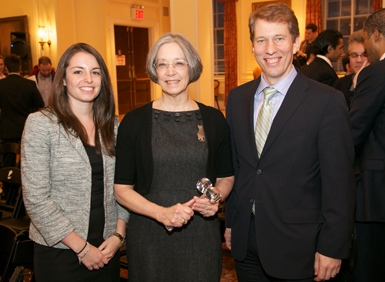The [i]Annual Survey of American Law[/i] honors Chief Judge Diane Wood
On the chilly afternoon of February 25, Chief Judge Diane Wood of the US Court of Appeals for the Seventh Circuit was warmly lauded by colleagues and friends—and compared to a giant of American jurisprudence and legal literature—as dedicatee of this year’s Annual Survey of American Law, Volume 71 of the student journal at New York University School of Law.
Wood is “the Learned Hand of our generation,” said Oscar Chase, Russell D. Niles Professor of Law at the Law School. He was referring to the Second Circuit appellate court's chief judge from the 1920s to the early '60s, whose eloquence is frequently cited by contemporary scholars, and whose name was often put forth for nomination to the nation’s high court.
Appointed to the Seventh Circuit in 1995 by President Bill Clinton, Wood was herself twice considered for the Supreme Court by President Barack Obama. And Mother Jones magazine touts her as “a rock star of the written word.”
“She is someone,” Chase said, “who could and should grace the Supreme Court.”
“Judge Wood is known for tactfully dealing with others, in sometimes prickly circumstances,” said NYU Law Dean Trevor Morrison, “not through grandstanding or combativeness, but by sheer intellectual force.”
That force, said Yael R. Tzipori ’14, editor-in-chief of the Annual Survey, shows law students that “it is possible to resolutely and articulately hold your position, even when you’re in the minority.”
Wood’s dissents often prevail in the end, notably in the 2008 matter of Bloch v. Frischolz, in which a Jewish family had affixed a mezuzah to the doorpost of their Chicago home—only to have it repeatedly removed by a condominium association, acting in accordance with building rules.
A three-member panel of the Seventh Circuit, including then Associate Judge Wood, declined to hear Bloch. Judge Wood’s dissent, based on the right to free expression, prompted the court to rehear the case en banc. Both her panel colleagues—Judges Richard Posner and Frank Easterbrook—eventually reversed themselves, joining the full court’s unanimous decision.
Eleanor Fox, Walter J. Derenberg Professor of Trade Regulation at NYU Law, is a 30-year friend of Wood and a fellow practitioner in antitrust law and international procedure. She said of Wood’s decisions: “They read like stories about people, which of course is what they are.”
In a 2003 essay for the University of Chicago Law Review, Wood championed civil liberties over unbridled government response to fears of additional terrorist strikes in the edgy aftermath of 9/11. In “The Rule of Law in Times of Stress,” she concluded:
[C]ourage will be necessary for all citizens now.… We do not need to fear the perceived shackles on government power.… They are not shackles at all; they are instead agreed restraints…so that any measures that are necessary are seen to be, and are in fact, evenhanded, non-discriminatory, subject to testing for accuracy, and transparent. Enemies—foreign and domestic—have been conquered effectively in the past without sacrificing everything that has made the United States a country with a strong record of exemplifying the rule of law. Those same enemies, in whatever guise they take in the future, can still be foiled in the same way.
Ross Davies, who clerked for Wood prior to joining the faculty of George Mason University School of Law, recounted the modesty of his one-time boss—in the form of a “funny-looking” framed certificate on the wall of her chambers.
It seems that her judicial commission, an embossed document signed by President Clinton, had failed to arrive in Chicago from Washington, DC, where Wood had served the antitrust division of the US Department of Justice as deputy assistant attorney general for international, appellate, and policy. But neither did a requested replacement arrive quite as anticipated.
Davies asked the judge about curious lettering affixed to the bottom edge of the ersatz document: in italic typeface, the words “duplicate” and “Bureau of Printing & Engraving.”
Why not obscure these extra words—plainly visible, slightly lopsided—with a frame that could mask evidence of a proxy?
Wood’s reasoning, according to Davies: “I don’t want it to appear to be anything but what it is. I simply want to be accurate.”
“This was a simple case of right and wrong for her,” said Davies. “Concealment? To what end? The duplicate leaves her decision as a disclosure.”
As presidential commissions go, Wood’s is “the homeliest, yet the most handsome,” said Davies. “This is small matter, maybe. But it is by this, and her decisions, that we know her and admire her.”
Wood’s own remarks were characteristically modest, and brief. She acknowledged embarrassment in sitting through the encomiums, and simply said, “Thank you.” Returning to her chair, she added, “I go to work every day hoping to do the right thing.”
Watch the video of the dedication (1 hr, 5 min):
Posted on March 4, 2014


